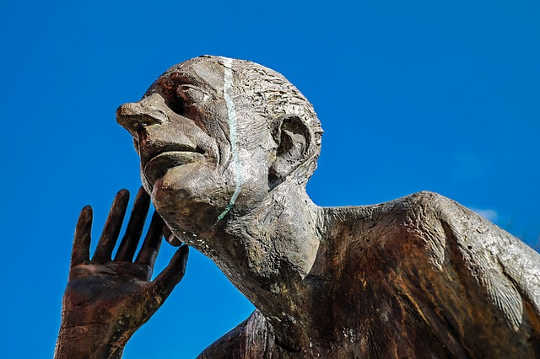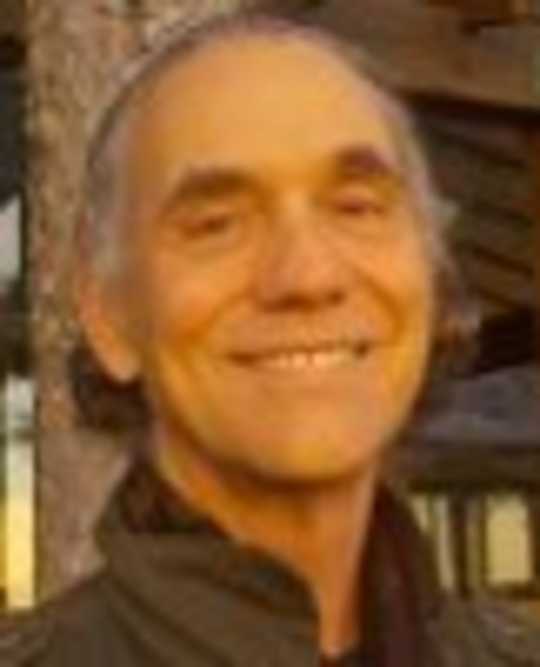
The problem with thoughts is not that we have so many of them but that we identify ourselves so closely with them. Thoughts come and go. Some are clearly more interesting than others. But regardless of their content, we take the emergence of thought seriously because we tend to believe that who we are is the silent speaker of all these thoughts, this mysterious character that we all refer to as “I.” Who silently forms and speaks these thoughts? I do.
Babies enter the world feeling merged with everything, but as we grow and mature, it’s vitally important that we leave the fusion behind and realize that there’s an important, qualitative difference between our physical body and everything else that we perceive outside of our body. And so we each become an I, a unique entity separate from everyone and everything else.
This radical shift in perception is a completely natural development, and it’s imperative that it occur. It signifies a maturation in our understanding of the world of physical reality and of our relationship to it, and if for any reason this natural progression from merging into separation doesn’t occur, the child will often have a great deal of trouble moving through a world that everyone else experiences differently.
Calm Mind of Buddha
From a Buddhist perspective, however, this development from merging to separation isn’t the end of the story. There’s yet a third phase of growth and development that could occur in the life of a maturing person, and this would be to grow beyond the rigid separatist perspective of I through rediscovering the substratum of union underlying the world of appearances that the baby had no choice but to experience.
But this rediscovery of the merged feeling of our infancy requires a progression of consciousness based on relaxation of body and calmness of mind, not a regression to the undifferentiated consciousness of the newly born. In this way the passage of life could trace a perfectly evolving spiral: from fusion with the world to separation from it and then on to a felt awareness that partakes of both.
And this cycle—from the substratum of undivided wholeness that pervades all physical form, to the clear and distinct separation that exists between those objects and forms, to the coterminous, and simultaneous, awareness of both dimensions—could represent the natural evolution of a human being whose mind is no longer stuck in or identified with thoughts of belief and bias and whose body has relaxed to allow the current of the life force to move more freely through its length.
The Heart Sutra, one of the most revered texts of Buddhism, tells us that everything partakes of these two dimensions. On one hand is the conventional reality of the world with which we’re so familiar, whose physical forms and objects appear solid, distinct, and eternally separate from one other. On the other hand is an absolute reality that permeates the entire world of physical form, whose pervasive substance, so subtle is its touch, feels much like a vast emptiness, and whose emotional tone emphasizes a felt sense of union, not separation.
The Heart Sutra alerts us to the existence of this parallel universe of pervasive emptiness, the polar opposite to the visible forms and objects of our conventional world, and implies that the purpose of the practice is to awaken an awareness of the simultaneous existence of these two dimensions, to be able to function nimbly in both, moving back and forth between them as the events in your life dictate. And to do that we need to let go of our identification with the ongoing parade of thoughts in our head and yield to the embodied impulse to move to this upper register of the evolutionary spiral.
Unlike puberty, there is no easily predetermined age at which this impulse gets unleashed and this perception of emptiness first realized. It may happen to some of us when we’re very young. It may happen when we’re older. It can happen at any time or not happen at all.
Holding On To The Egoic Perspective
Unlike the powerful hormonal energies of puberty that virtually no one can resist, we have the ability to block this culmination of the evolutionary spiral of life from ever occurring. So strong is the egoic fixation on the second level of separation (I, after all, is a clear and strident demarcation of separation) that we mostly stay attached to its separatist perspective throughout our life.
We tend to resist the altogether natural evolutionary impulse to move beyond our limited self and into the restful embrace of what the Buddha referred to as the nibbanic condition, where we see that the worlds of form and all-pervasive space are but different perspectives of the one reality. It’s as though we hold on to ourselves, but end up losing what’s rightfully ours.
Furthermore, the way we hold on to the egoic perspective and restrict this evolutionary force is to bring tension into the body, and as soon as unnecessary tension enters into the body, turmoil in the mind is not far behind.
Surrendering To The Awakened Evolutionary Currents
The Buddha believed that the suffering we experience—the unrest in our minds and the discomfort in our bodies—is the direct result of resisting the current and innate intelligence of the life force and wanting things to be different from how they are.
Life happens, whether we want it to or not. The energies of puberty are unleashed, whether we want them to be or not. And if we simply surrender to and ride upon these awakened evolutionary currents, they’ll take us into the third phase of the evolutionary spiral—and nothing could be more natural.
And yet, for most of us, most of the time, the unchecked caravan of thoughts, with its intrinsic linguistic bias that supports the perspective of separation (words, after all, name objects and states as unique and different from one another), just parades on and on without any apparent ability on our part to do anything about it.
But, once again, if we start waking up to what has formerly been so unconscious—the breath that sustains our life, as well as the constantly shifting, changing, and morphing sights, sounds, and feelings of this present moment—the body can remember to relax and thoughts can lessen, and as thought evaporates and dissolves, so too does the speaker of those thoughts.
Pulling The Plug On The Parade Of Thoughts
When the mind is quiet and language is absent, the I doesn’t have any stable ground on which to stand. And when the rug gets pulled from underneath the I, then we immediately and naturally settle back down into the dimension of consciousness that the Buddha looked upon as our intrinsic birthright.
Pull the plug on the parade of thoughts, and our claustrophobic identity that relates only to the world of solid form dissolves into the greater ground state, not unlike how an individual droplet of water eventually makes its way back to the ocean and becomes part of it.
The Sufis have a fundamentally similar expression for the softening of the egoic fiction and the settling out of the turbulent parade of thoughts that ordinarily consume the mind. They say that you have to “die before you die.' In no way are they speaking of a premature death of the physical body.
What they’re pointing to instead is the melting away of the quality of mind, and of the tension in the body that supports and fuels it, that relates to life only through the perspective of separation, of “I.' If we can enact this dissolution, this melting of the rigidity of the egoic perspective, what starts emerging to take its place is a kind of exhilarated presence and awareness that doesn’t have to view the world through the distorting lens of the separatist concept “I.”
In a similar fashion, the Western religious philosopher William James coined the term sciousness to describe the same condition of mind, a mind calm and clear, a mirror of awareness free of the distorting waves of thought that so disturb mind’s innate tranquillity and clarity, a consciousness that does not need the intermediation of an I to engage the world.
Replacing Turbulence With Quiescence
A mind that has replaced turbulence with quiescence is a mind in which the unchecked procession of thoughts has slowed to the point of insignificance. And, when thought slows to a pace and place of negligibility, what happens to the speaker of all those thoughts, the “I”? It too fades away and melts, receding so far into the background of awareness to be revealed as illusory.
From the perspective of the world of separation, the egoic fixation of the mind is very real. What’s fictitious about it, though, is that it believes it’s the only perspective that exists, and this belief doesn’t allow the further evolution into the third level of the spiral to occur. Furthermore, our attachment to the consciousness of separation and our resistance to the evolutionary current that wants to shepherd us on to the third phase of the spiral requires that we introduce a sophisticated pattern of holding and bracing into the tissues of the body, and this unnecessary tension hurts.
The primary path to this melting of mind, from the perspective of the Buddha, is through paying as close attention as possible to the phenomenon and process of breathing while reorienting your awareness to the sounds, visions, and sensations that you can hear, see, and feel right now.
What is also necessary is that you don’t become so attached to anything—any vision, sound, sensation, pattern of breath—that you want to hold on to it forever, which can never occur, or push it away because you don’t like or want it.
Both holding on and pushing away are expressions of resistance to the ever-changing events and flow of what life presents you in this moment, and the Buddha tells us that to align yourself more viscerally with this flow you need to breathe, relax, and remain aware. Breathing in . . . breathing out. Seeing. Hearing. Feeling. Just breathing and remaining aware. And remembering to relax.
The path that the Buddha outlines for us is not an aggressive path in which we strive to attack the turbulent mind, to demolish and destroy it, to put it out of its—and our—misery. You can’t forcibly stop the mind. You can only breathe and be aware. Eventually, over time, the accumulated moments of awareness work their magic. The conditioned rigidity of body and mind starts to melt, replaced by a felt sense of flow at the levels of both feeling presence of the body and thoughtforms in the mind.
If you want to know what the Buddha knew, you have to do what the Buddha did. If you want to know what the Buddha knew, sit down and breathe. And remain aware. You needn’t strive to attain some special state or some unique insight.
Be as aware as you can of the feeling presence of the body, of the breath as it enters and leaves the body, of the fields of vision, sound, and sensation that surround and penetrate you. And, as much as possible, stay in touch with the mystery of the present moment, whose only constant is that its contents always change.
Just do the practice, and watch as body relaxes and the mind becomes quieter. What happens to your I when this relaxation and quietude replace the tension and turbulence?
Copyright 2018 by Will Johnson. All Rights Reserved.
Reprinted with permission. Publisher: Inner Traditions Intl.
www.innertraditions.com
Article Source
Cannabis in Spiritual Practice: The Ecstasy of Shiva, the Calm of Buddha
by Will Johnson
 With the end of marijuana prohibition on the horizon, people are now openly seeking a spiritual path that embraces the benefits of cannabis. Drawing upon his decades of experience as a teacher of Buddhism, breathing, yoga, and embodied spirituality, Will Johnson examines Eastern spiritual perspectives on marijuana and offers specific guidelines and exercises for integrating cannabis into spiritual practice.
With the end of marijuana prohibition on the horizon, people are now openly seeking a spiritual path that embraces the benefits of cannabis. Drawing upon his decades of experience as a teacher of Buddhism, breathing, yoga, and embodied spirituality, Will Johnson examines Eastern spiritual perspectives on marijuana and offers specific guidelines and exercises for integrating cannabis into spiritual practice.
Click here for more info and/or to order this paperback book and/or download the Kindle edition.
About the Author
 Will Johnson is the director of the Institute for Embodiment Training, a teaching school in Costa Rica that views the body as the doorway, not the obstacle, to real spiritual growth and transformation. The author of several books, including Breathing through the Whole Body, The Spiritual Practices of Rumi, and Eyes Wide Open, he teaches a deeply body-oriented approach to sitting meditation at Buddhist centers around the world. Visit his website at http://www.embodiment.net.
Will Johnson is the director of the Institute for Embodiment Training, a teaching school in Costa Rica that views the body as the doorway, not the obstacle, to real spiritual growth and transformation. The author of several books, including Breathing through the Whole Body, The Spiritual Practices of Rumi, and Eyes Wide Open, he teaches a deeply body-oriented approach to sitting meditation at Buddhist centers around the world. Visit his website at http://www.embodiment.net.
Video with Will Johnson: Relaxing in the Body of Meditation
{vembed Y=37nRdptKlOU}
Related Books
at InnerSelf Market and Amazon



























